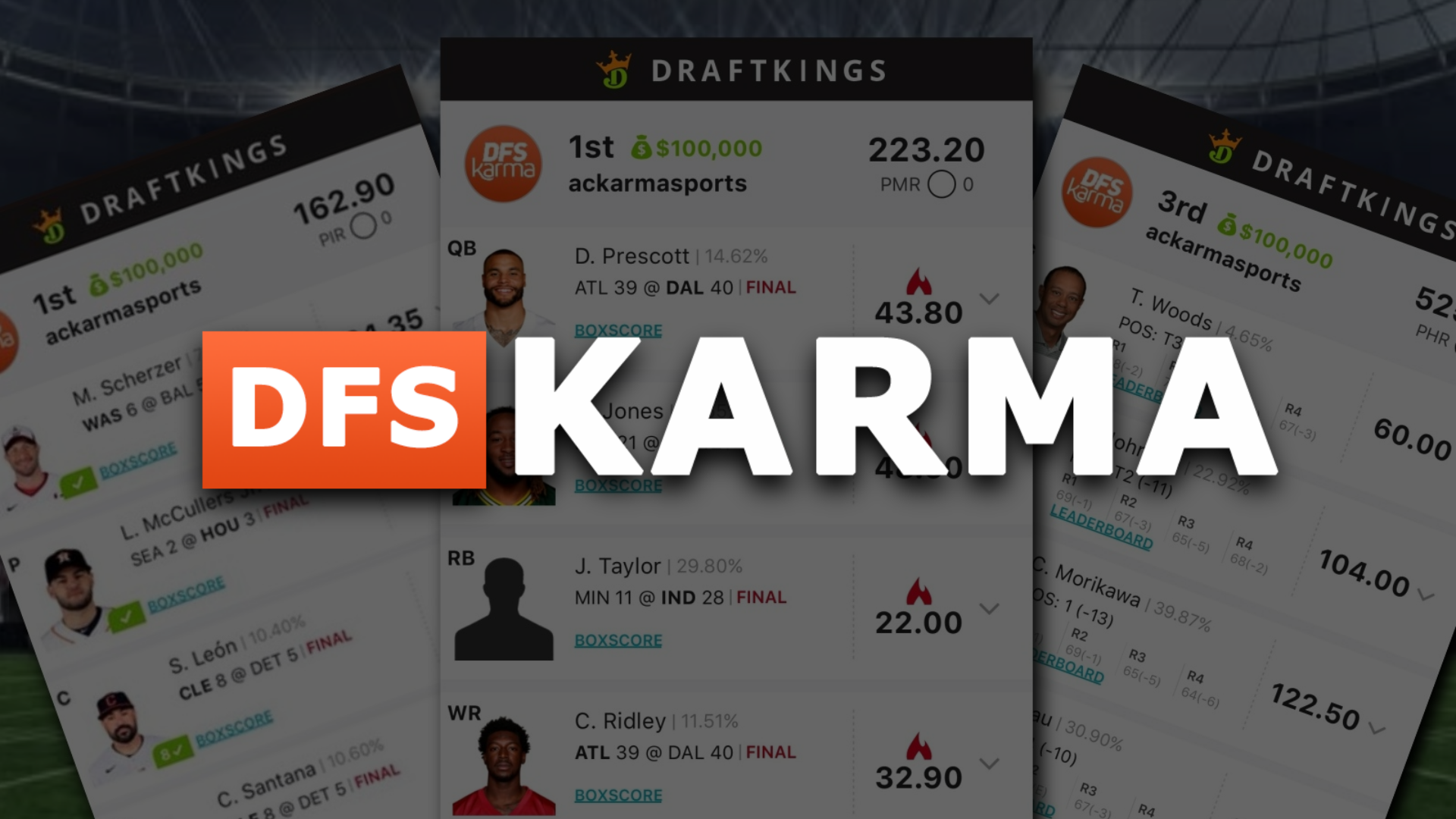
Welcome to Bales’ Top Best Ball Values for the 2021 NFL season. In this article, I’ll outline players at each of the four positions that I believe are values at their current ADP. The ADPs are taken directly from Underdog Fantasy.
If you don’t have an Underdog account yet, click the banner below to sign up, and use promo code KARMA to be eligible for our exclusive bonuses!
No Waivers. No Trades. No Setting Lineups. Just Drafting.
Quarterback
Ryan Fitzpatrick
Fitzpatrick made plenty of noise last season, throwing for 2,091 yards with 13 touchdowns and 8 interceptions over 9 games (7 starts). He added 151 yards and 2 touchdowns on the ground, as well. In his 7 starts, he averaged 20.7 fantasy points per game, scoring 18+ fantasy points in 6 of those 7 contests. He also flashed 25+ fantasy point upside in those games. Ultimately, Fitzpatrick averaged the 11th most fantasy points per game of any quarterback with more than 5 starts.
With Tua Tagovailoa completely taking over in Miami, Fitzpatrick signed with the Washington Football Team. Washington is clearly in win-now mode, suggesting Fitzpatrick won’t have to worry about being replaced this season. Alex Smith retired, Washington didn’t add any quarterbacks in the draft, and Taylor Heinicke, Kyle Allen, and Steven Montez are far from elite competition for Fitzpatrick. He will benefit from having an outstanding supporting cast, including Terry McLaurin, Curtis Samuel, Antonio Gibson, Logan Thomas, and J.D. McKissic. Washington added protection along the offensive line with Samuel Cosmi, as well. Fitzpatrick’s currently being drafted as the QB21 (ADP: 154.2), behind Kirk Cousins, Tagovailoa, and Baker Mayfield. Although he isn’t necessarily the best real-life quarterback in the NFL, Fitzpatrick boasts more than enough upside to be a steal at his current ADP.
Ryan Tannehill
Tannehill continues to be one of the most disrespected quarterbacks in the NFL. He performed extremely well last season, throwing for 3,819 yards with 33 touchdowns, and 7 interceptions over 16 games. He added 266 and 7 touchdowns on the ground, as well. Tannehill posted 17+ fantasy points in 13 of his 16 games, including several games with 28+ fantasy points. He ended the season as QB7.
Tannehill’s in a similar situation as last season, although the Tennessee Titans lost a few key offensive pieces. Corey Davis, Jonnu Smith, and Adam Humphries all left this offseason. I’m not overly worried about Anthony Firkser taking over for Smith, although Josh Reynolds replacing Davis is a major downgrade. With that being said, I expect the passing attack to revolve more around AJ Brown, who saw only 106 targets last season. I also expect Derrick Henry to add more to the passing game this season. Tannehill’s current ADP sits at 124.3, and he’s being selected as the QB16. He has the potential to lead all quarterbacks in scoring in plus matchups, making this price tag far too low in any Best Ball format.
Running Back
JK Dobbins
Dobbins enjoyed an outstanding rookie season, rushing for 805 yards and 9 touchdowns on only 134 carries. He added 18 receptions for 120 yards on only 24 targets. Dobbins ranked second in the NFL in yards before contact (3.1) and yards after contact (2.9) per attempt, while playing only 44% of the offensive snaps last season. Dobbins was the most efficient red zone option for Baltimore last season, scoring on 32% of his red zone carries. Most importantly, he scored on 87.5% of his carries inside-the-5, while Gus Edwards and Lamar Jackson scored on only 30% of their opportunities in the same situation.
Dobbins will be splitting snaps and carries once again this season. With that being said, I expect him to start earning more snaps from Edwards, as he continues to flash at an elite level. Dobbins should see a larger role in the red zone, as he was by far Baltimore’s most efficient option. He’s also the top receiving option in the backfield, and the Ravens could be forced to throw more if they’re losing games. Dobbins has an ADP of 28.7, and he’s being selected as the RB17. With Jackson and Edwards steals carries, Dobbins averaged over 15 fantasy points per game when he had double-digit carries last season. I’m expecting an increased role this season, and he’s an RB1 possibility.
David Montgomery
We’re in the season where proven players get overlooked for upside options. Montgomery broke out last season, posting 1,070 yards and 8 touchdowns on 247 carries over 15 games. He added 54 receptions for 438 yards and 2 touchdowns on 68 targets, as well. Montgomery was a true workhorse last season, playing 71% of the Chicago Bears snaps. He ranked third in the NFL in broken tackles (29) and second in broken tackles per attempt (8.5). Most importantly, Montgomery saw 66.7% of Chicago’s red zone carries, turning 44 carries into 137 yards and 7 touchdowns. He posted 6 receptions for 42 yards and 1 touchdown on 10 red zone targets, as well.
The Bears added Damien Williams and Khalil Herbert to their running back room, while Tarik Cohen will return from injury. It’s clear Montgomery likely won’t quite find 70% of the snaps again this season, although he was out snapping Cohen early last season before his injury. Herbert is a work in progress, while Williams is likely an insurance policy, leaving Montgomery to continue to play a major role in the offense, even if it’s slightly less than last season. He ended the 2020 season as the RB4, averaging the seventh-most fantasy points per game of any running backs that played 5 or more games. He’s being selected as the RB20 with a 36.7 ADP. Montgomery’s a proven talent that isn’t one of the flashier names at the moment, causing his stock to drop.
Wide Receiver
Terry McLaurin
McLaurin’s coming off of an outstanding season, posting 87 receptions for 1,118 yards and 4 touchdowns on 134 targets for the Washington Football Team. He saw 1,286 air yards with a 9.6 aDOT. Overall, McLaurin accounted for 36% of Washington’s air yards last season. He recorded a 23.4% target share from Alex Smith, Dwayne Haskins, Kyle Allen, and Taylor Heinicke last season. Unsurprisingly, McLaurin’s biggest struggles came in the red zone, where he turned 12 targets into 5 receptions for 26 yards and only 1 touchdown. His drop rate sat at only 2.2% last season, suggesting he can add to his touchdown total if he gets more stable quarterback play.
Insert Ryan Fitzpatrick. Fitzpatrick’s gunslinger mentality will open up Washington’s offense, specifically for McLaurin. He adds an upside to the receiving group that the quarterbacks last year couldn’t match, as the Washington running backs and tight ends combined for roughly 275 targets. McLaurin ended last season as the WR21 with conservative quarterbacks, although he’s currently being selected as the WR13 with an ADP of 36.1. You aren’t getting McLaurin at a discount like some of the other players in this article, but he boasts high-end WR1 upside with Fitzpatrick running the offense. I’m expecting him to get even better this year, specifically finding the end zone at a higher rate.
Breshad Perriman
Would it really be one of my Best Ball articles if I didn’t outline Perriman? He’s coming off of another injury-filled year, recording 30 receptions for 505 yards and 3 touchdowns on 60 targets over 12 games. In limited time, he saw 936 air yards with an outstanding 15.6 aDOT. Perriman struggled to find success in the red zone, posting only 1 reception for 15 yards and 1 touchdown on 6 targets. He simply wasn’t a massive part of a rebuilding New York Jets offense, even though he played the majority of the snaps when healthy.
Perriman gets another opportunity with a rebuilding team this season. He signed with the Detroit Lions, who have very little in terms of wide receiver depth. Tyrell Williams and Kalif Raymond are penciled in as starters, although Amon-Ra St. Brown will likely take over in the slot at some point this season. There’s a clear path for the 27-year-old Perriman to turn into Detroit’s WR1 this season. Although I don’t expect them to feature a prolific offense, I do expect them to be throwing quite a bit as they lose games. Perriman’s currently free at his 150 ADP. He’s being drafted as the WR64 because of injury concerns, inconsistent production, and question marks surrounding Detroit’s offense. He’ll continue to boast plenty of big-play ability with the potential to command targets as the Lions play from behind, making him an outstanding Best Ball option.
Tight End
Jared Cook
Cook was a breakout candidate for the New Orleans Saints last season, as many believe he would finish as one of the top tight ends. He posted 37 receptions for 504 yards and 7 touchdowns on 60 targets, ending the season as the TE17. Cook’s decreased catch rate wasn’t necessarily his fault, though, as he posted only 2 drops or a 3.3% drop rate. Instead, his lack of production can be attributed to the erratic quarterback play of a declining Drew Brees and Taysom Hill.
Cook will be shifting to a more stable offense that boasts similar upside this season. He signed a one-year deal with the Los Angeles Chargers, adding another weapon for their promising young quarterback, Justin Herbert. Cook will take over for Hunter Henry, who needed only 14 games to end the season as the TE14. Los Angeles bolstered their offensive line in the draft, while only adding Josh Palmer to their receiving group. Cook could immediately slide into Henry’s 90+ targets, while his catch rate could increase to upwards of 65%, similar to his last couple of years. He owns an ADP of 170.9 or the TE23. Outside of the top guys, there are plenty of boom or bust options. Cook’s playing in a great situation but going overlooked as he enters the tail end of his career. He’s being drafted as a low-end TE2, but he boasts TE1 upside in the Chargers’ offense.
Follow Bales on Twitter (@BalesSJustin)







